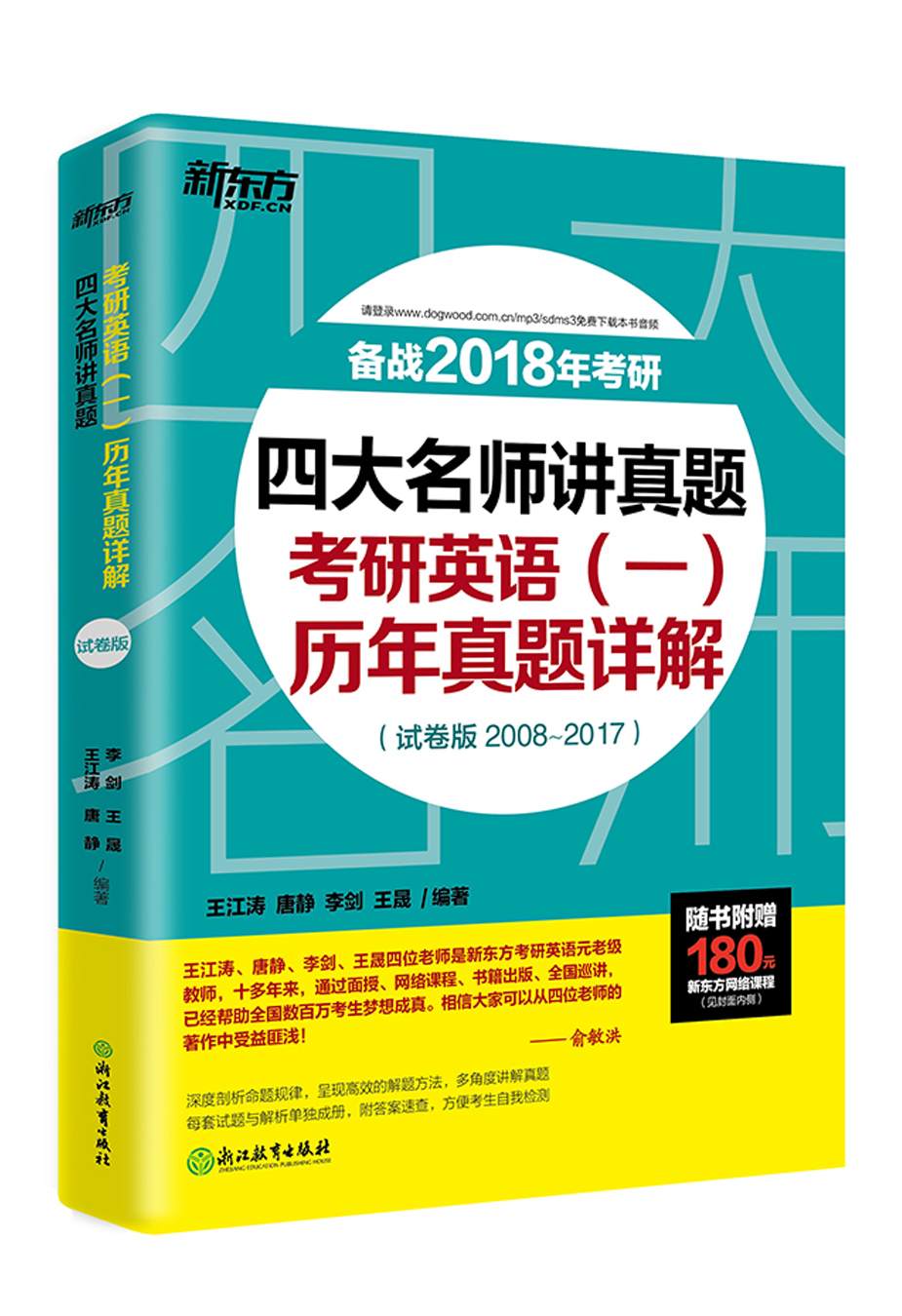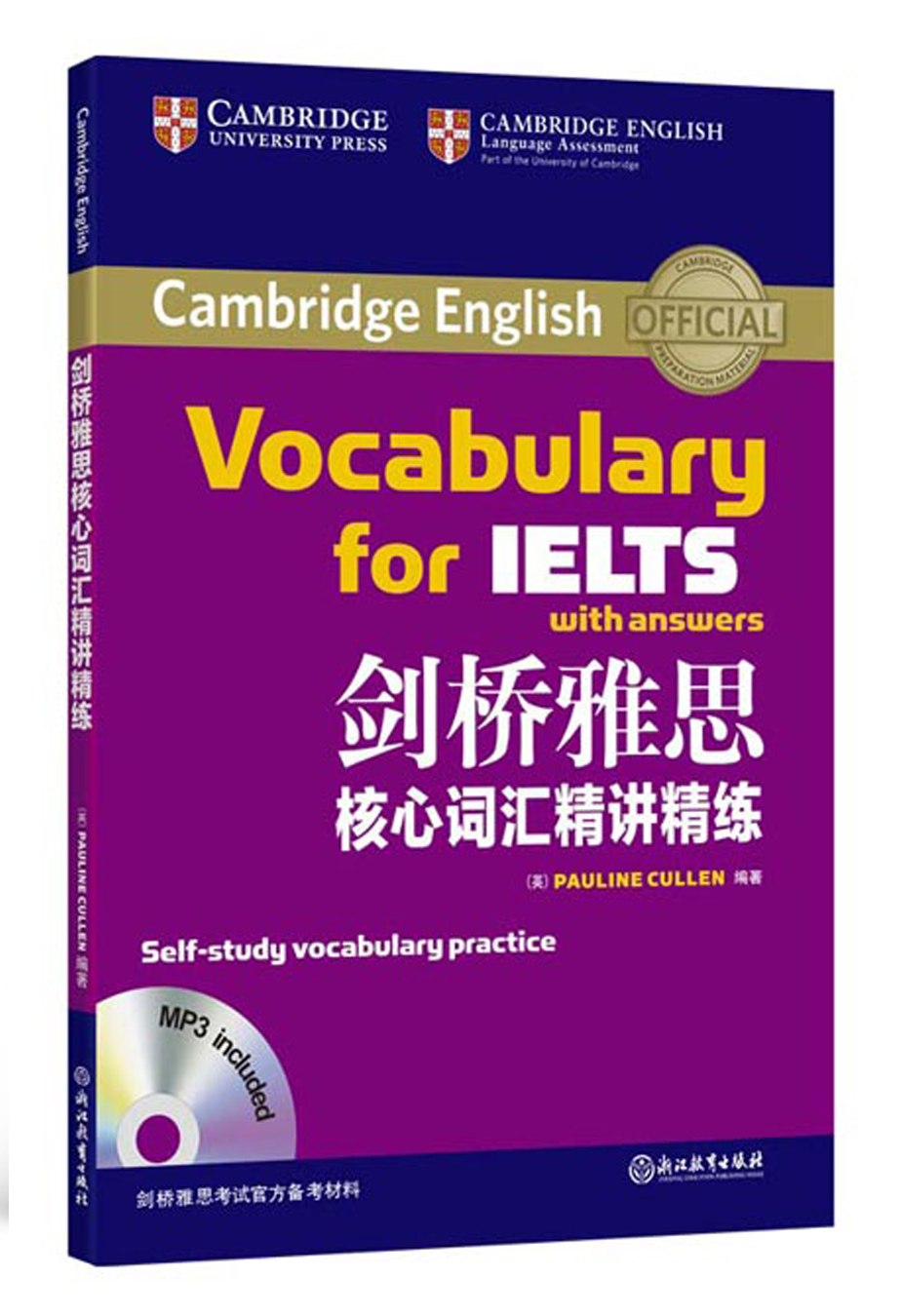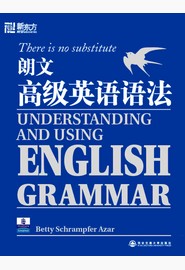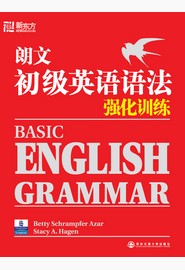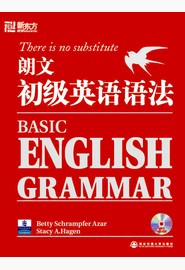朗文高级英语语法
其它购书方式: 新东方书友会邮购
读者,您好!如遇到音频无法下载的情况,请您及时与我们的维护人员联系,联系电话:62605588-188。
相关图书
编辑推荐
作为世界上最畅销的英语语法教材之一,《朗文英语语法》系列教材在培养中国学生的英语实际应用能力方面,开创了一个全新的视野和学习思路。
许多在国外畅销的语法教材,来到国内都面临着叫好不叫座的尴尬。究其原因,主要是因为国内的英语课堂教学模式使大部分学生对语法的认识停留在课堂笔记中,对语法的应用止步于单项选择题。随之而来的是,语法既是学生的强项,同时又成了一大弊病—太多的条条框框成为阻碍学生自由表达的桎梏,缺乏输出方面的引导和有效的训练使得英语语法的诸多细则无法被“盘活”。久而久之,学生的英语思维越来越僵化,在以交流为导向的国外主流语言教材面前变得无所适从。所以,一套好的语法教材,不仅应该能够简单扼要、提纲挈领地讲解语法规则,而且要能够将语法知识与其在真实语言环境中的实际应用紧密地结合起来,让学生真正体会到语法学习的成就感和趣味性,就这一点来说,《朗文英语语法》系列带给我们许多有益的启示。
首先,这套教材根据不同级别的学生的水平和需求,对纷繁复杂的英语语法点进行了合理的梳理和编排,使学 生可以结合自己的实际情况循序渐进地轻松掌握语法知识。其次,对语法规则的叙述和讲解可读性极强,通俗易懂,学起来不会让人感到枯燥乏味。再次,每个语法点都配备了形式多样的练习,这些练习均源自一个朴素的教学理念,即“应用和沟通是语言学习的最终目的”。通过这些基于真实语境的练习,学生可以在实际应用中不断加深对语法规则的记忆和理解,学习效率也会随之大大提高。
另外,这套教材的每个级别都配有对应的强化训练册。建议大家对练习的内容要力争做到熟读、口头复述甚至改写,这种看似单调的训练方法却是最直接有效的,可以帮助大家从认知到模仿,直至最后能够诠释自己的生活,在有效重复中逐渐完成从量变到质变,最终体会语言应用的最高境界,即语感(linguistic intuition)。
美国人说:“Use the word three times, and it’s yours.”我们始终坚信,英语语法不是“学”出来的,而是“用”出来的。希望大家在语法学习中也能化被动接受为主动表达,在反复的练习中体会把枯燥的语言规则转化为自如交流的快乐!
前言:
《朗文高级英语语法》(Understanding and using of English Grammar)是一本专门为中级水平的英语学习者提高语法技能而量身定做的教材。本书以语法为核心,同时通过各种方法帮助学习者全面提升各项语言技能。本书既可以用作课堂教材,也可以作为参考资料供学生自学。
和以往的版本相比,第三版不仅保留了折衷教学法(eclectic approach)和大量多样的练习,而且在多个方面进行了充实:
●进一步扩充了交流方面的内容,且表述得更加清晰、明确。教材中有大量“真实交 流”的机会供教师利用。这些内容以学生的生活经历为语言环境,从中选取有趣的话题,激励学生通过有组织的开放式讨论来自由地表达自己的观点。设置这种活动主要是基于很多经验丰富的教师们的观点,即以语法为基础的学习与通过口语交流来学习不是相互排斥的,而是相互促进的,这两种方式可以在同一个语言教程中、同一个班上,甚至同一节课上一起使用并且能够相互促进。
●更加注重互动性。第三版教材将许多以前标有“口语”或“口语(合上书)”的内容,重新编排成更容易操作的两人练习或小组练习。当然,在教师的带领下也可以进行全班练习。第三版教材鼓励互动,同时也给使用者留出了足够的空间,让其自行决定什么程度的互动最适合他们的需要。
●练习的种类更加丰富。第三版教材增加了自由回答练习和开放式交流任务,依旧提供大量控制性练习题,以加深学生对要学习的语法结构的形式、意义和用法的最初理解。同时,还包括了更多的写作话题、口语活动、错误分析练习和情景扩展练习。
●篇幅较长的章节已经被拆分成了较短的章节,某些语法单元也进行了重新编排。
第三版教材封面上有一只展翅高飞的燕子。在世界各地都能看到燕子的身影,它们是快乐、顽皮、生机勃勃的鸟儿,它们的来去往往预示着季节的转换。这只燕子标志着新的开始——学生、教师和教材的编者携手并进,踏上新的语言学习之路。
本书姊妹篇:
① 朗文中级英语语法
② 朗文初级英语语法
许多在国外畅销的语法教材,来到国内都面临着叫好不叫座的尴尬。究其原因,主要是因为国内的英语课堂教学模式使大部分学生对语法的认识停留在课堂笔记中,对语法的应用止步于单项选择题。随之而来的是,语法既是学生的强项,同时又成了一大弊病—太多的条条框框成为阻碍学生自由表达的桎梏,缺乏输出方面的引导和有效的训练使得英语语法的诸多细则无法被“盘活”。久而久之,学生的英语思维越来越僵化,在以交流为导向的国外主流语言教材面前变得无所适从。所以,一套好的语法教材,不仅应该能够简单扼要、提纲挈领地讲解语法规则,而且要能够将语法知识与其在真实语言环境中的实际应用紧密地结合起来,让学生真正体会到语法学习的成就感和趣味性,就这一点来说,《朗文英语语法》系列带给我们许多有益的启示。
首先,这套教材根据不同级别的学生的水平和需求,对纷繁复杂的英语语法点进行了合理的梳理和编排,使学 生可以结合自己的实际情况循序渐进地轻松掌握语法知识。其次,对语法规则的叙述和讲解可读性极强,通俗易懂,学起来不会让人感到枯燥乏味。再次,每个语法点都配备了形式多样的练习,这些练习均源自一个朴素的教学理念,即“应用和沟通是语言学习的最终目的”。通过这些基于真实语境的练习,学生可以在实际应用中不断加深对语法规则的记忆和理解,学习效率也会随之大大提高。
另外,这套教材的每个级别都配有对应的强化训练册。建议大家对练习的内容要力争做到熟读、口头复述甚至改写,这种看似单调的训练方法却是最直接有效的,可以帮助大家从认知到模仿,直至最后能够诠释自己的生活,在有效重复中逐渐完成从量变到质变,最终体会语言应用的最高境界,即语感(linguistic intuition)。
美国人说:“Use the word three times, and it’s yours.”我们始终坚信,英语语法不是“学”出来的,而是“用”出来的。希望大家在语法学习中也能化被动接受为主动表达,在反复的练习中体会把枯燥的语言规则转化为自如交流的快乐!
前言:
《朗文高级英语语法》(Understanding and using of English Grammar)是一本专门为中级水平的英语学习者提高语法技能而量身定做的教材。本书以语法为核心,同时通过各种方法帮助学习者全面提升各项语言技能。本书既可以用作课堂教材,也可以作为参考资料供学生自学。
和以往的版本相比,第三版不仅保留了折衷教学法(eclectic approach)和大量多样的练习,而且在多个方面进行了充实:
●进一步扩充了交流方面的内容,且表述得更加清晰、明确。教材中有大量“真实交 流”的机会供教师利用。这些内容以学生的生活经历为语言环境,从中选取有趣的话题,激励学生通过有组织的开放式讨论来自由地表达自己的观点。设置这种活动主要是基于很多经验丰富的教师们的观点,即以语法为基础的学习与通过口语交流来学习不是相互排斥的,而是相互促进的,这两种方式可以在同一个语言教程中、同一个班上,甚至同一节课上一起使用并且能够相互促进。
●更加注重互动性。第三版教材将许多以前标有“口语”或“口语(合上书)”的内容,重新编排成更容易操作的两人练习或小组练习。当然,在教师的带领下也可以进行全班练习。第三版教材鼓励互动,同时也给使用者留出了足够的空间,让其自行决定什么程度的互动最适合他们的需要。
●练习的种类更加丰富。第三版教材增加了自由回答练习和开放式交流任务,依旧提供大量控制性练习题,以加深学生对要学习的语法结构的形式、意义和用法的最初理解。同时,还包括了更多的写作话题、口语活动、错误分析练习和情景扩展练习。
●篇幅较长的章节已经被拆分成了较短的章节,某些语法单元也进行了重新编排。
第三版教材封面上有一只展翅高飞的燕子。在世界各地都能看到燕子的身影,它们是快乐、顽皮、生机勃勃的鸟儿,它们的来去往往预示着季节的转换。这只燕子标志着新的开始——学生、教师和教材的编者携手并进,踏上新的语言学习之路。
本书姊妹篇:
① 朗文中级英语语法
② 朗文初级英语语法
作者简介
Betty Schrampfer Azar ——
从事英语语言教学研究和语法教材编写工作四十余年,对英语语法体系及语法教学有深入的研究和独到的见解,出版过多部经典语法教材。
从事英语语言教学研究和语法教材编写工作四十余年,对英语语法体系及语法教学有深入的研究和独到的见解,出版过多部经典语法教材。
图书目录
第一章 动词时态概述 (Overview Of Verb Tenses)
1-1 一般时态 (The Simple Tenses)……………………… 2
1-2 进行时态 (The Progressive Tenses)…………………3
1-3 完成时态 (The Perfect Tenses)……………………… 4
1-4 完成进行时态 (The Perfect Progressive Tenses)……5
1-5 时态用法总结 (Summary Chart of Verb Tenses)……6
1-6 -ing 和-ed形式的拼写 (Spelling of -ing and -ed Forms) ………………………………………………………10
第二章 一般现在时,一般过去时,现在进行时和过去进行时 (Present And Past, Simple And Progressive)
2-1 一般现在时 (Simple Present)………………………13
2-2 现在进行时 (Present Progressive)…………………13
2-3 静态动词(Stative Verbs)……………………………15
2-4 am/is/are being+形容词(am/is/are being + Adjective)
………………………………………………………17
2-5 规则动词和不规则动词 (Regular and Irregular Verbs)
………………………………………………………19
2-6 规则动词:-ed的发音(Regular Verbs: Pronunciation of -ed Endings)…………………………………………………20
2-7 不规则动词表 (Irregular Verbs: an Alphabetical List)
………………………………………………………………22
2-8 易混淆的动词:raise/rise, set/sit, lay/lie
(Troublesome Verbs: raise/rise, set/sit, lay/lie) ………26
2-9 一般过去时(Simple Past)……………………………27
2-10 过去进行时(Past Progressive)………………………28
2-11 进行时态与always连用表示抱怨 (Using Progressive Verbs with always to Complain)……………………………30
2-12 进行时态中地点状语的用法 (Using Expressions of Place with Progressive Verbs)………………………………31
第三章 完成时和完成进行时 (Perfect And Perfect Progressive Tenses)
3-1 现在完成时 (Present Perfect)………………………36
3-2 现在完成进行时(Present Perfect Progressive)…… 42
3-3 过去完成时(Past Perfect)……………………………45
3-4 过去完成进行时 (Past Perfect Progressive)…………47
第四章 将来时 (Future Time)
4-1 一般将来时:will 和be going to (Simple Future: will and be going to) ……………………………………………51
4-2 will与be going to的比较 (will vs. be going to)……52
4-3 用时间状语从句表示将来 (Expressing the Future in Time Clauses)………………………………………………55
4-4 用一般现在时和现在进行时表示将来
(Using the Present Progressive and the Simple Present to Express Future Time)………………………………57
4-5 将来进行时 (Future Progressive) …………………60
4-6 将来完成时 (Future Perfect)…………………………62
4-7 将来完成进行时 (Future Perfect Progressive)………62
第五章 时间状语从句和时态的复习 (Adverb Clauses Of Time And Review Of Verb Tenses)
5-1 时间状语从句:形式(Adverb Clauses of Time: Form)
………………………………………………………70
5-2 用时间状语从句表示时间关系 (Using Adverb Clauses to Show Time Relationships)………………………………72
第六章 主谓一致 (Subject-verb Agreement)
6-1 以-s或-es结尾的词:用法、发音和拼写 (Final -s/-es: Use, Pronunciation, and Spelling) …………………………84
6-2 基本的主谓一致问题 (Basic Subject-verb Agreement)
………………………………………………………88
6-3 主谓一致:表达数量 (Subject-verb Agreement: Using Expressions of Quantity)……………………………………89
6-4 主谓一致:there be的用法(Subject-verb Agreement: Using there + be)…………………………………………90
6-5 主谓一致:不规则用法 (Subject-verb Agreement: Some Irregularities)………………………………………………92
第七章 名 词 (Nouns)
7-1 名词复数形式的规则和不规则变化(Regular and Irregular Plural Nouns)……………………………………100
7-2 所有格(Possessive Nouns)…………………………103
7-3 名词作修饰语 (Using Nouns as Modifiers)………105
7-4 可数名词和不可数名词(Count and Noncount Nouns)
………………………………………………………107
7-5 不可数名词(Noncount Nouns)……………………108
7-6 常见不可数名词 (Some Common Noncount Nouns)
………………………………………………………108
7-7 冠词的基本用法 (Basic Article Usage)……………112
7-8 冠词用法的基本原则(General Guidelines for Article Usage)……………………………………………………115
7-9 数量的表达(Expressions of Quantity)………………119
7-10 a few和few,a little和little的用法 (Using a few and few; a little and little)………………………………………123
7-11 带of 的数量表达 (Using of in Expressions of Quantity)…………………………………………………125
7-12 all (of) 和both (of)〔All (of) and both (of)…………126
7-13 单数的数量表达:one, each, every
(Singular Expressions of Quantity: one, each, every)
………………………………………………………128
第八章 代 词 (Pronouns)
8-1 人称代词(Personal Pronouns)………………………132
8-2 人称代词:与类属名词、不定代词的一致性
(Personal Pronouns: Agreement with Generic Nouns and Indefinite Pronouns)…………………………………134
8-3 人称代词:与集合名词的一致性 (Personal Pronouns: Agreement with Collective Nouns)………………………136
8-4 反身代词 (Reflexive Pronouns)……………………138
8-5 you, one和they用作非人称代词 (Using you, one, and they as Impersonal Pronouns)…………………………140
8-6 other的形式 (Forms of other)………………………142
8-7 other的常见表达 (Common Expressions with other)
………………………………………………………145
第九章 情态动词(一) (Modals, Part 1)
9-1 概述(Introduction)…………………………………151
9-2 I作主语的礼貌请求(Polite Questions with I as the Subject)……………………………………………………152
9-3 you作主语的礼貌请求 (Polite Questions with you as the Subject)………………………………………………152
9-4 would you mind用作礼貌请求 (Polite Requests with would you mind)…………………………………………153
9-5 表示必须:must, have to, have got to
(Expressing Necessity: must, have to, have got to)…157
9-6 不必要和禁止:have to和must的否定形式
(Lack of Necessity and Prohibition: have to and must in the Negative)…………………………………………158
9-7 忠告:should, ought to, had better
(Advisability: should, ought to, had better)…………160
9-8 should的过去式(The Past Form of should)…………163
9-9 期望:be supposed to (Expectations: be supposed to)
………………………………………………………166
9-10 提议:let’s, why don’t, shall I/we
(Making Suggestions: let’s, why don’t, shall I/we)…169
9-11 提议:could与should的比较 (Making Suggestions: could vs. should)…………………………………………171
第十章 情态动词(二) (Modals, Part 2)
10-1 表示确定程度:现在时 (Degrees of Certainty: Present Time)………………………………………………………176
10-2 表示确定程度:现在时的否定形式 (Degrees of Certainty: Present Time Negative) ………………………178
10-3 表示确定程度:过去时 (Degrees of Certainty: Past Time)………………………………………………………181
10-4 表示确定程度:将来时 (Degrees of Certainty: Future Time)………………………………………………………184
10-5 情态动词的进行式 (Progressive Forms of Modals)
………………………………………………………188
10-6 表示能力:can和could (Ability: can and could) ………………………………………………………193
10-7 would表示过去重复性的动作
(Using would to Express a Repeated Action in the Past) ………………………………………………………195
10-8 表示倾向:would rather (Expressing Preference: would rather)………………………………………………………197
10-9 情态动词和短语情态动词的结合 (Combining Modals with Phrasal Modals)………………………………………198
10-10 情态动词和类似表达的总结表 (Summary Chart of Modals and Similar Expressions)…………………………199
第十一章 被动语态 (The Passive)
11-1 被动语态的构成(Forming the Passive)……………208
11-2 被动语态的用法 (Using the Passive)………………211
11-3 间接宾语用作被动语态的主语 (Indirect Objects Used as Passive Subjects)………………………………………213
11-4 情态动词与短语情态动词的被动语态
(The Passive Form of Modals and Phrasal Modals)…218
11-5 静态被动语态 (Stative Passive)……………………225
11-6 常见静态被动语态动词 + 介词 (Common Stative Passive Verbs + Prepositions)……………………………228
11-7 get与被动语态 (The Passive with get)……………232
11-8 分词形容词 (Participial Adjectives)………………235
第十二章 名词性从句 (Noun Clauses)
12-1 概述 (Introduction)…………………………………239
12-2 以疑问词开头的名词性从句 (Noun Clauses Beginning with a Question Word) ……………………………………240
12-3 以whether或if开头的名词性从句 (Noun Clauses Beginning with whether or if)……………………………245
12-4 疑问词后接不定式(Question Words Followed by Infinitives)…………………………………………………247
12-5 以that开头的名词性从句 (Noun Clauses Beginning with that)…………………………………………………248
12-6 直接引语 (Quoted Speech)…………………………251
12-7 间接引语:名词性从句中动词的形式 (Reported Speech: Verb Forms in Noun Clauses)……………………254
12-8 名词性从句中虚拟语气的用法 (Using the Subjunctive in Noun Clauses) …………………………………………263
12-9 带有-ever的词汇的用法 (Using -ever Words)……265
第十三章 定语从句 (Adjective Clauses)
13-1 概述 (Introduction)…………………………………267
13-2 定语从句的关系代词作主语 (Adjective Clause Pronouns Used as the Subject)……………………………268
13-3 定语从句的关系代词作动词的宾语
(Adjective Clause Pronouns Used as the Object of a Verb) ………………………………………………………268
13-4 定语从句的关系代词作介词的宾语
(Adjective Clause Pronouns Used as the Object of a Preposition)…………………………………………269
13-5 定语从句的常用句型(Usual Patterns of Adjective Clauses)……………………………………………………270
13-6 whose的用法 (Using whose)………………………274
13-7 定语从句中where的用法 (Using where in Adjective Clauses)……………………………………………………277
13-8 定语从句中when的用法(Using when in Adjective Clauses)……………………………………………………277
13-9 定语从句修饰代词的用法 (Using Adjective Clauses to Modify Pronouns)…………………………………………280
13-10 定语从句中标点符号的使用 (Punctuating Adjective Clauses)……………………………………………………281
13-11 定语从句中数量的表示方法 (Using Expressions of Quantity in Adjective Clauses)……………………………285
13-12 名词+of which 的用法(Using Noun + of which)…286
13-13 which修饰整个句子的用法 (Using which to Modify a Whole Sentence)…………………………………………286
13-14 将定语从句简化为形容词短语:概述
(Reducing Adjective Clauses to Adjective Phrases: Introduction)…………………………………………290
13-15 将定语从句转变为形容词短语 (Changing an Adjective Clause to an Adjective Phrase)…………………290
第十四章 动名词和不定式(一) (Gerunds And Infinitives, Part 1)
14-1 动名词:概述 (Gerunds: Introduction) ……………297
14-2 动名词作介词的宾语 (Using Gerunds as the Objects of Prepositions)………………………………………………298
14-3 后面接动名词的常见介词短语 (Common Preposition Combinations Followed by Gerunds)……………………299
14-4 后面接动名词的常见动词 (Common Verbs Followed by Gerunds)………………………………………………302
14-5 go+动名词 (go + Gerund)…………………………303
14-6 后面接动词-ing形式的固定搭配 (Special Expressions Followed by -ing)…………………………………………304
14-7 后面接不定式的常见动词 (Common Verbs Followed by Infinitives)………………………………………………307
14-8 后面既可接不定式又可接动名词的常见动词
(Common Verbs Followed by either Infinitives or Gerunds)……………………………………………311
14-9 后面接动名词的动词列表(Reference List of Verbs Followed by Gerunds) ……………………………………318
14-10 后面接不定式的动词列表 (Reference List of Verbs Followed by Infinitives)……………………………………319
14-11 it +不定式;动名词和不定式作主语(it + Infinitive; Gerunds and Infinitives as Subjects)………………………323
第十五章 动名词和不定式(二) (Gerunds And Infinitives, Part 2)
15-1 表示目的的不定式:in order to (Infinitive of Purpose: in order to)……………………………………………………326
15-2 后面接不定式的形容词 (Adjectives Followed by Infinitives)…………………………………………………328
15-3 不定式与too和enough连用 (Using Infinitives with too and enough)………………………………………………330
15-4 不定式和动名词的被动语态和完成式 (Passive and Past Forms of Infinitives and Gerunds)……………………331
15-5 need后接动名词或不定式的被动语态形式 (Using Gerunds or Passive Infinitives Following need)…………333
15-6 所有格修饰动名词 (Using a Possessive to Modify a Gerund)……………………………………………………334
15-7 感官动词的用法 (Using Verbs of Perception)……336
15-8 let和help后接动词原形 (Using the Simple Form after let and help)………………………………………………338
15-9 使役动词的用法:make, have, get (Using Causative Verbs: make, have, get)……………………………………339
第十六章 并列连词 (Coordinating Conjunctions)
16-1 平行结构 (Parallel Structure) 348
16-2 成对连词:both…and; not only…but also; either…or; neither…nor (Using Paired Conjunctions: both . . . and; not only . . . but also; either . . . or; neither . . . nor)…………353
16-3 用并列连词连接独立分句 (Combining Independent Clauses with Coordinating Conjunctions)…………………355
第十七章 状语从句 (Adverb Clauses)
17-1 概述(Introduction)…………………………………359
17-2 原因状语从句(Using Adverb Clauses to Show Cause and Effect) …………………………………………………362
17-3 表达对比(意外的结果):even though的用法
〔Expressing Contrast (Unexpected Result): Using even though〕……………………………………………………363
17-4 表达直接对比:while和whereas (Showing Direct Contrast: while and whereas)………………………………366
17-5 条件状语从句:if从句 (Expressing Conditions in Adverb Clauses: if-clauses)………………………………367
17-6 条件状语从句:whether or not 和even if 的用法
(Adverb Clauses of Condition: Using whether or not and even if)………………………………………………368
17-7 条件状语从句:in case 和in the event that的用法
(Adverb Clauses of Condition: Using in case and in the event that)……………………………………………369
17-8 条件状语从句:unless的用法 (Adverb Clauses of Condition: Using unless)…………………………………370
17-9 条件状语从句:only if的用法 (Adverb Clauses of Condition: Using only if)…………………………………371
第十八章 将状语从句简化为修饰性的副词短语
(Reduction Of Adverb Clauses To Modifying Adverbial Phrases)
18-1 概述(Introduction)…………………………………374
18-2 将时间状语从句简化为修饰性的副词短语
(Changing Time Clauses to Modifying Adverbial Phrases)………………………………………………375
18-3 用修饰性的副词短语表达“与此同时”的概念
(Expressing the Idea of “During the Same Time” in Modifying Adverbial Phrases)………………………376
18-4 用修饰性的副词短语表示因果关系
(Expressing Cause and Effect in Modifying Adverbial Phrases)………………………………………………376
18-5 在修饰性的副词短语中使用 “upon + -ing” (Using upon + -ing in Modifying Adverbial Phrases)……………380
第十九章 表示因果、对比和条件关系的关联词
(Connectives That Express Cause And Effect, Contrast, And Condition)
19-1 because of 和due to的用法 (Using because of and due to)…………………………………………………………385
19-2 用过渡词表示因果关系:therefore和consequently
(Using Transitions to Show Cause and Effect: therefore and consequently)……………………………………387
19-3 句型和标点符号小结 (Summary of Patterns and Punctuation)………………………………………………389
19-4 其它表示因果关系的方式:such…that和so…that
(Other Ways of Expressing Cause and Effect: such . . . that and so . . . that)…………………………………391
19-5 表示目的:so that的用法 (Expressing Purpose: Using so that)……………………………………………………393
19-6 表示对比(意料之外的结果)〔Showing Contrast (Unexpected Result)〕……………………………………395
19-7 表示直接对比 (Showing Direct Contrast)…………398
19-8 表示条件:otherwise和or(else)的用法
〔Expressing Conditions: Using otherwise and or (else)〕
……………………………………………………401
19-9 关联词小结:因果、对比和条件关系
(Summary of Connectives: Cause and Effect, Contrast, Condition)………………………………402
第二十章 条件句和表达愿望的方式 (Conditional Sentences And Wishes)
20-1 条件句中一般动词形式概述
(Overview of Basic Verb Forms Used in Conditional Sentences)…………………………………………………413
20-2 现在和将来的真实条件句 (True in the Present or Future)……………………………………………………414
20-3 现在和将来的非真实条件句(与事实相反)
〔Untrue (Contrary to Fact) in the Present or Future〕……415
20-4 过去的非真实条件句 (与事实相反)〔Untrue (Contrary to Fact) in the Past〕……………………………418
20-5 在条件句中使用动词的进行时形式
(Using Progressive Verb Forms in Conditional Sentences) ………………………………………………………423
20-6 条件句中“混合时间”的用法(Using “Mixed Time” in Conditional Sentences)…………………………………424
20-7 if 的省略 (Omitting if)……………………………424
20-8 暗含的条件(Implied Conditions)…………………425
20-9 as if/as though的用法 (Using as if/as though)……430
20-10 wish后面的动词形式 (Verb Forms Following wish) ………………………………………………………432
20-11 用would表达对于未来的希望(Using would to Make Wishes about the Future)…………………………………434
附录 增补语法单元 (Supplementary Grammar Units)
A单元:基本语法术语 (Basic Grammar Terminology)
A-1 主语、动词和宾语 (Subjects, Verbs, and Objects)…A1
A-2 介词和介词短语 (Prepositions and Prepositional Phrases)……………………………………………………A3
A-3 形容词 (Adjectives)…………………………………A4
A-4 副词 (Adverbs)………………………………………A4
A-5 be动词 (The Verb be)………………………………A6
A-6 系动词 (Linking Verbs)……………………………A6
B单元:疑问句 (Questions)
B-1 一般疑问句和特殊疑问句的形式 (Forms of Yes/No and Information Questions)………………………………A8
B-2 疑问词(Question Words)……………………………A9
B-3 简化的一般疑问句 (Shortened Yes/No Questions)
………………………………………………………A12
B-4 否定疑问句 (Negative Questions)…………………A13
B-5 反意疑问句 (Tag Questions)………………………A15
C单元: 缩写 (Contractions)…………………………A17
D单元:否定句 (Negatives)
D-1 not与其它否定词的用法 (Using not and Other Negative Words)…………………………………………A18
D-2 避免“重复两次否定”(Avoiding Double Negatives) ……………………………………………………A20
D-3 以否定词开头的句子(Beginning a Sentence with a Negative Word)……………………………………………A20
E单元:介词搭配 (Preposition Combinations)
E 形容词和动词的介词搭配 (Preposition Combinations with Adjectives and Verbs)………………………………A21
F单元:用来举例和延续观点的关联词 (Connectives To Give Examples And To Continue An Idea)
F-1 用来举例的关联词 (Connectives to Give Examples)
………………………………………………………A24
F-2 用来延续观点的关联词 (Connectives to Continue the Same Idea) ………………………………………………A26
G单元:动词形式的回顾练习 (Verb Form Review Exercises)…………………………………………………A26
1-1 一般时态 (The Simple Tenses)……………………… 2
1-2 进行时态 (The Progressive Tenses)…………………3
1-3 完成时态 (The Perfect Tenses)……………………… 4
1-4 完成进行时态 (The Perfect Progressive Tenses)……5
1-5 时态用法总结 (Summary Chart of Verb Tenses)……6
1-6 -ing 和-ed形式的拼写 (Spelling of -ing and -ed Forms) ………………………………………………………10
第二章 一般现在时,一般过去时,现在进行时和过去进行时 (Present And Past, Simple And Progressive)
2-1 一般现在时 (Simple Present)………………………13
2-2 现在进行时 (Present Progressive)…………………13
2-3 静态动词(Stative Verbs)……………………………15
2-4 am/is/are being+形容词(am/is/are being + Adjective)
………………………………………………………17
2-5 规则动词和不规则动词 (Regular and Irregular Verbs)
………………………………………………………19
2-6 规则动词:-ed的发音(Regular Verbs: Pronunciation of -ed Endings)…………………………………………………20
2-7 不规则动词表 (Irregular Verbs: an Alphabetical List)
………………………………………………………………22
2-8 易混淆的动词:raise/rise, set/sit, lay/lie
(Troublesome Verbs: raise/rise, set/sit, lay/lie) ………26
2-9 一般过去时(Simple Past)……………………………27
2-10 过去进行时(Past Progressive)………………………28
2-11 进行时态与always连用表示抱怨 (Using Progressive Verbs with always to Complain)……………………………30
2-12 进行时态中地点状语的用法 (Using Expressions of Place with Progressive Verbs)………………………………31
第三章 完成时和完成进行时 (Perfect And Perfect Progressive Tenses)
3-1 现在完成时 (Present Perfect)………………………36
3-2 现在完成进行时(Present Perfect Progressive)…… 42
3-3 过去完成时(Past Perfect)……………………………45
3-4 过去完成进行时 (Past Perfect Progressive)…………47
第四章 将来时 (Future Time)
4-1 一般将来时:will 和be going to (Simple Future: will and be going to) ……………………………………………51
4-2 will与be going to的比较 (will vs. be going to)……52
4-3 用时间状语从句表示将来 (Expressing the Future in Time Clauses)………………………………………………55
4-4 用一般现在时和现在进行时表示将来
(Using the Present Progressive and the Simple Present to Express Future Time)………………………………57
4-5 将来进行时 (Future Progressive) …………………60
4-6 将来完成时 (Future Perfect)…………………………62
4-7 将来完成进行时 (Future Perfect Progressive)………62
第五章 时间状语从句和时态的复习 (Adverb Clauses Of Time And Review Of Verb Tenses)
5-1 时间状语从句:形式(Adverb Clauses of Time: Form)
………………………………………………………70
5-2 用时间状语从句表示时间关系 (Using Adverb Clauses to Show Time Relationships)………………………………72
第六章 主谓一致 (Subject-verb Agreement)
6-1 以-s或-es结尾的词:用法、发音和拼写 (Final -s/-es: Use, Pronunciation, and Spelling) …………………………84
6-2 基本的主谓一致问题 (Basic Subject-verb Agreement)
………………………………………………………88
6-3 主谓一致:表达数量 (Subject-verb Agreement: Using Expressions of Quantity)……………………………………89
6-4 主谓一致:there be的用法(Subject-verb Agreement: Using there + be)…………………………………………90
6-5 主谓一致:不规则用法 (Subject-verb Agreement: Some Irregularities)………………………………………………92
第七章 名 词 (Nouns)
7-1 名词复数形式的规则和不规则变化(Regular and Irregular Plural Nouns)……………………………………100
7-2 所有格(Possessive Nouns)…………………………103
7-3 名词作修饰语 (Using Nouns as Modifiers)………105
7-4 可数名词和不可数名词(Count and Noncount Nouns)
………………………………………………………107
7-5 不可数名词(Noncount Nouns)……………………108
7-6 常见不可数名词 (Some Common Noncount Nouns)
………………………………………………………108
7-7 冠词的基本用法 (Basic Article Usage)……………112
7-8 冠词用法的基本原则(General Guidelines for Article Usage)……………………………………………………115
7-9 数量的表达(Expressions of Quantity)………………119
7-10 a few和few,a little和little的用法 (Using a few and few; a little and little)………………………………………123
7-11 带of 的数量表达 (Using of in Expressions of Quantity)…………………………………………………125
7-12 all (of) 和both (of)〔All (of) and both (of)…………126
7-13 单数的数量表达:one, each, every
(Singular Expressions of Quantity: one, each, every)
………………………………………………………128
第八章 代 词 (Pronouns)
8-1 人称代词(Personal Pronouns)………………………132
8-2 人称代词:与类属名词、不定代词的一致性
(Personal Pronouns: Agreement with Generic Nouns and Indefinite Pronouns)…………………………………134
8-3 人称代词:与集合名词的一致性 (Personal Pronouns: Agreement with Collective Nouns)………………………136
8-4 反身代词 (Reflexive Pronouns)……………………138
8-5 you, one和they用作非人称代词 (Using you, one, and they as Impersonal Pronouns)…………………………140
8-6 other的形式 (Forms of other)………………………142
8-7 other的常见表达 (Common Expressions with other)
………………………………………………………145
第九章 情态动词(一) (Modals, Part 1)
9-1 概述(Introduction)…………………………………151
9-2 I作主语的礼貌请求(Polite Questions with I as the Subject)……………………………………………………152
9-3 you作主语的礼貌请求 (Polite Questions with you as the Subject)………………………………………………152
9-4 would you mind用作礼貌请求 (Polite Requests with would you mind)…………………………………………153
9-5 表示必须:must, have to, have got to
(Expressing Necessity: must, have to, have got to)…157
9-6 不必要和禁止:have to和must的否定形式
(Lack of Necessity and Prohibition: have to and must in the Negative)…………………………………………158
9-7 忠告:should, ought to, had better
(Advisability: should, ought to, had better)…………160
9-8 should的过去式(The Past Form of should)…………163
9-9 期望:be supposed to (Expectations: be supposed to)
………………………………………………………166
9-10 提议:let’s, why don’t, shall I/we
(Making Suggestions: let’s, why don’t, shall I/we)…169
9-11 提议:could与should的比较 (Making Suggestions: could vs. should)…………………………………………171
第十章 情态动词(二) (Modals, Part 2)
10-1 表示确定程度:现在时 (Degrees of Certainty: Present Time)………………………………………………………176
10-2 表示确定程度:现在时的否定形式 (Degrees of Certainty: Present Time Negative) ………………………178
10-3 表示确定程度:过去时 (Degrees of Certainty: Past Time)………………………………………………………181
10-4 表示确定程度:将来时 (Degrees of Certainty: Future Time)………………………………………………………184
10-5 情态动词的进行式 (Progressive Forms of Modals)
………………………………………………………188
10-6 表示能力:can和could (Ability: can and could) ………………………………………………………193
10-7 would表示过去重复性的动作
(Using would to Express a Repeated Action in the Past) ………………………………………………………195
10-8 表示倾向:would rather (Expressing Preference: would rather)………………………………………………………197
10-9 情态动词和短语情态动词的结合 (Combining Modals with Phrasal Modals)………………………………………198
10-10 情态动词和类似表达的总结表 (Summary Chart of Modals and Similar Expressions)…………………………199
第十一章 被动语态 (The Passive)
11-1 被动语态的构成(Forming the Passive)……………208
11-2 被动语态的用法 (Using the Passive)………………211
11-3 间接宾语用作被动语态的主语 (Indirect Objects Used as Passive Subjects)………………………………………213
11-4 情态动词与短语情态动词的被动语态
(The Passive Form of Modals and Phrasal Modals)…218
11-5 静态被动语态 (Stative Passive)……………………225
11-6 常见静态被动语态动词 + 介词 (Common Stative Passive Verbs + Prepositions)……………………………228
11-7 get与被动语态 (The Passive with get)……………232
11-8 分词形容词 (Participial Adjectives)………………235
第十二章 名词性从句 (Noun Clauses)
12-1 概述 (Introduction)…………………………………239
12-2 以疑问词开头的名词性从句 (Noun Clauses Beginning with a Question Word) ……………………………………240
12-3 以whether或if开头的名词性从句 (Noun Clauses Beginning with whether or if)……………………………245
12-4 疑问词后接不定式(Question Words Followed by Infinitives)…………………………………………………247
12-5 以that开头的名词性从句 (Noun Clauses Beginning with that)…………………………………………………248
12-6 直接引语 (Quoted Speech)…………………………251
12-7 间接引语:名词性从句中动词的形式 (Reported Speech: Verb Forms in Noun Clauses)……………………254
12-8 名词性从句中虚拟语气的用法 (Using the Subjunctive in Noun Clauses) …………………………………………263
12-9 带有-ever的词汇的用法 (Using -ever Words)……265
第十三章 定语从句 (Adjective Clauses)
13-1 概述 (Introduction)…………………………………267
13-2 定语从句的关系代词作主语 (Adjective Clause Pronouns Used as the Subject)……………………………268
13-3 定语从句的关系代词作动词的宾语
(Adjective Clause Pronouns Used as the Object of a Verb) ………………………………………………………268
13-4 定语从句的关系代词作介词的宾语
(Adjective Clause Pronouns Used as the Object of a Preposition)…………………………………………269
13-5 定语从句的常用句型(Usual Patterns of Adjective Clauses)……………………………………………………270
13-6 whose的用法 (Using whose)………………………274
13-7 定语从句中where的用法 (Using where in Adjective Clauses)……………………………………………………277
13-8 定语从句中when的用法(Using when in Adjective Clauses)……………………………………………………277
13-9 定语从句修饰代词的用法 (Using Adjective Clauses to Modify Pronouns)…………………………………………280
13-10 定语从句中标点符号的使用 (Punctuating Adjective Clauses)……………………………………………………281
13-11 定语从句中数量的表示方法 (Using Expressions of Quantity in Adjective Clauses)……………………………285
13-12 名词+of which 的用法(Using Noun + of which)…286
13-13 which修饰整个句子的用法 (Using which to Modify a Whole Sentence)…………………………………………286
13-14 将定语从句简化为形容词短语:概述
(Reducing Adjective Clauses to Adjective Phrases: Introduction)…………………………………………290
13-15 将定语从句转变为形容词短语 (Changing an Adjective Clause to an Adjective Phrase)…………………290
第十四章 动名词和不定式(一) (Gerunds And Infinitives, Part 1)
14-1 动名词:概述 (Gerunds: Introduction) ……………297
14-2 动名词作介词的宾语 (Using Gerunds as the Objects of Prepositions)………………………………………………298
14-3 后面接动名词的常见介词短语 (Common Preposition Combinations Followed by Gerunds)……………………299
14-4 后面接动名词的常见动词 (Common Verbs Followed by Gerunds)………………………………………………302
14-5 go+动名词 (go + Gerund)…………………………303
14-6 后面接动词-ing形式的固定搭配 (Special Expressions Followed by -ing)…………………………………………304
14-7 后面接不定式的常见动词 (Common Verbs Followed by Infinitives)………………………………………………307
14-8 后面既可接不定式又可接动名词的常见动词
(Common Verbs Followed by either Infinitives or Gerunds)……………………………………………311
14-9 后面接动名词的动词列表(Reference List of Verbs Followed by Gerunds) ……………………………………318
14-10 后面接不定式的动词列表 (Reference List of Verbs Followed by Infinitives)……………………………………319
14-11 it +不定式;动名词和不定式作主语(it + Infinitive; Gerunds and Infinitives as Subjects)………………………323
第十五章 动名词和不定式(二) (Gerunds And Infinitives, Part 2)
15-1 表示目的的不定式:in order to (Infinitive of Purpose: in order to)……………………………………………………326
15-2 后面接不定式的形容词 (Adjectives Followed by Infinitives)…………………………………………………328
15-3 不定式与too和enough连用 (Using Infinitives with too and enough)………………………………………………330
15-4 不定式和动名词的被动语态和完成式 (Passive and Past Forms of Infinitives and Gerunds)……………………331
15-5 need后接动名词或不定式的被动语态形式 (Using Gerunds or Passive Infinitives Following need)…………333
15-6 所有格修饰动名词 (Using a Possessive to Modify a Gerund)……………………………………………………334
15-7 感官动词的用法 (Using Verbs of Perception)……336
15-8 let和help后接动词原形 (Using the Simple Form after let and help)………………………………………………338
15-9 使役动词的用法:make, have, get (Using Causative Verbs: make, have, get)……………………………………339
第十六章 并列连词 (Coordinating Conjunctions)
16-1 平行结构 (Parallel Structure) 348
16-2 成对连词:both…and; not only…but also; either…or; neither…nor (Using Paired Conjunctions: both . . . and; not only . . . but also; either . . . or; neither . . . nor)…………353
16-3 用并列连词连接独立分句 (Combining Independent Clauses with Coordinating Conjunctions)…………………355
第十七章 状语从句 (Adverb Clauses)
17-1 概述(Introduction)…………………………………359
17-2 原因状语从句(Using Adverb Clauses to Show Cause and Effect) …………………………………………………362
17-3 表达对比(意外的结果):even though的用法
〔Expressing Contrast (Unexpected Result): Using even though〕……………………………………………………363
17-4 表达直接对比:while和whereas (Showing Direct Contrast: while and whereas)………………………………366
17-5 条件状语从句:if从句 (Expressing Conditions in Adverb Clauses: if-clauses)………………………………367
17-6 条件状语从句:whether or not 和even if 的用法
(Adverb Clauses of Condition: Using whether or not and even if)………………………………………………368
17-7 条件状语从句:in case 和in the event that的用法
(Adverb Clauses of Condition: Using in case and in the event that)……………………………………………369
17-8 条件状语从句:unless的用法 (Adverb Clauses of Condition: Using unless)…………………………………370
17-9 条件状语从句:only if的用法 (Adverb Clauses of Condition: Using only if)…………………………………371
第十八章 将状语从句简化为修饰性的副词短语
(Reduction Of Adverb Clauses To Modifying Adverbial Phrases)
18-1 概述(Introduction)…………………………………374
18-2 将时间状语从句简化为修饰性的副词短语
(Changing Time Clauses to Modifying Adverbial Phrases)………………………………………………375
18-3 用修饰性的副词短语表达“与此同时”的概念
(Expressing the Idea of “During the Same Time” in Modifying Adverbial Phrases)………………………376
18-4 用修饰性的副词短语表示因果关系
(Expressing Cause and Effect in Modifying Adverbial Phrases)………………………………………………376
18-5 在修饰性的副词短语中使用 “upon + -ing” (Using upon + -ing in Modifying Adverbial Phrases)……………380
第十九章 表示因果、对比和条件关系的关联词
(Connectives That Express Cause And Effect, Contrast, And Condition)
19-1 because of 和due to的用法 (Using because of and due to)…………………………………………………………385
19-2 用过渡词表示因果关系:therefore和consequently
(Using Transitions to Show Cause and Effect: therefore and consequently)……………………………………387
19-3 句型和标点符号小结 (Summary of Patterns and Punctuation)………………………………………………389
19-4 其它表示因果关系的方式:such…that和so…that
(Other Ways of Expressing Cause and Effect: such . . . that and so . . . that)…………………………………391
19-5 表示目的:so that的用法 (Expressing Purpose: Using so that)……………………………………………………393
19-6 表示对比(意料之外的结果)〔Showing Contrast (Unexpected Result)〕……………………………………395
19-7 表示直接对比 (Showing Direct Contrast)…………398
19-8 表示条件:otherwise和or(else)的用法
〔Expressing Conditions: Using otherwise and or (else)〕
……………………………………………………401
19-9 关联词小结:因果、对比和条件关系
(Summary of Connectives: Cause and Effect, Contrast, Condition)………………………………402
第二十章 条件句和表达愿望的方式 (Conditional Sentences And Wishes)
20-1 条件句中一般动词形式概述
(Overview of Basic Verb Forms Used in Conditional Sentences)…………………………………………………413
20-2 现在和将来的真实条件句 (True in the Present or Future)……………………………………………………414
20-3 现在和将来的非真实条件句(与事实相反)
〔Untrue (Contrary to Fact) in the Present or Future〕……415
20-4 过去的非真实条件句 (与事实相反)〔Untrue (Contrary to Fact) in the Past〕……………………………418
20-5 在条件句中使用动词的进行时形式
(Using Progressive Verb Forms in Conditional Sentences) ………………………………………………………423
20-6 条件句中“混合时间”的用法(Using “Mixed Time” in Conditional Sentences)…………………………………424
20-7 if 的省略 (Omitting if)……………………………424
20-8 暗含的条件(Implied Conditions)…………………425
20-9 as if/as though的用法 (Using as if/as though)……430
20-10 wish后面的动词形式 (Verb Forms Following wish) ………………………………………………………432
20-11 用would表达对于未来的希望(Using would to Make Wishes about the Future)…………………………………434
附录 增补语法单元 (Supplementary Grammar Units)
A单元:基本语法术语 (Basic Grammar Terminology)
A-1 主语、动词和宾语 (Subjects, Verbs, and Objects)…A1
A-2 介词和介词短语 (Prepositions and Prepositional Phrases)……………………………………………………A3
A-3 形容词 (Adjectives)…………………………………A4
A-4 副词 (Adverbs)………………………………………A4
A-5 be动词 (The Verb be)………………………………A6
A-6 系动词 (Linking Verbs)……………………………A6
B单元:疑问句 (Questions)
B-1 一般疑问句和特殊疑问句的形式 (Forms of Yes/No and Information Questions)………………………………A8
B-2 疑问词(Question Words)……………………………A9
B-3 简化的一般疑问句 (Shortened Yes/No Questions)
………………………………………………………A12
B-4 否定疑问句 (Negative Questions)…………………A13
B-5 反意疑问句 (Tag Questions)………………………A15
C单元: 缩写 (Contractions)…………………………A17
D单元:否定句 (Negatives)
D-1 not与其它否定词的用法 (Using not and Other Negative Words)…………………………………………A18
D-2 避免“重复两次否定”(Avoiding Double Negatives) ……………………………………………………A20
D-3 以否定词开头的句子(Beginning a Sentence with a Negative Word)……………………………………………A20
E单元:介词搭配 (Preposition Combinations)
E 形容词和动词的介词搭配 (Preposition Combinations with Adjectives and Verbs)………………………………A21
F单元:用来举例和延续观点的关联词 (Connectives To Give Examples And To Continue An Idea)
F-1 用来举例的关联词 (Connectives to Give Examples)
………………………………………………………A24
F-2 用来延续观点的关联词 (Connectives to Continue the Same Idea) ………………………………………………A26
G单元:动词形式的回顾练习 (Verb Form Review Exercises)…………………………………………………A26
